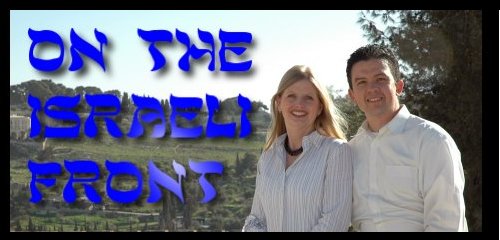Israel's History Revealed in the Rubble
December 07, 2005
Israel's History Revealed in the RubbleSee more pictures from the Dig site. Arrowheads launched by invading Babylonians, coins used by the Maccabeans, capstones from temple columns, inscriptions on priestly pottery, dice used by the 10th Roman legion, and various other artifacts left from the Babylonian, Persian, Roman, Ottoman, and even the British empires are being unearthed in the rubble that has been dumped into the Kidron valley from off of the holiest site in all of Israel: The Temple Mount. The Temple Mount makes up 1/6th of the Old City of Jerusalem. It is a large piece of real estate that currently houses the Al-Aqsa mosque as well as the Mosque of Omar, more commonly known as the "Dome of the Rock". The Temple Mount area is kept in trust by the Islamic Waqf, who is responsible for its upkeep and preservation for future generations. In 1999 the Waqf conducted an illicit excavation on the Temple Mount in an effort to expand the Al-Aqsa mosque. A pit 40 Meters wide and 12 Meters deep was dug into thousands of years of untouched historical data. Using bulldozers and dump trucks, the Waqf discarded 70 loads of sacred soil into the Kidron Valley. After several years of legal battles, archaeologists have now been given the opportunity to sift through the debris and make some of the world's most amazing discoveries.
Many coins from Israel's past have been found including a coin from Israel's first revolt against the Roman Empire with the inscription "Freedom of Zion" stamped into it in ancient Hebrew script. Two other notable coins have been uncovered; one from the Hasmonean dynasty, the time of the Maccabeans revolt, with an ancient Hebrew inscription "John the high priest and the council of the Jews" and the other a gold Napoleon the 3rd coin from 1858 when westerners were first allowed onto the Temple Mount. "Coins are small historical documents" says Dr. Barkay as he beams over his rare collection. But coins are only a small portion of the immense amount of archaeological finds that have been exposed.
Because the Temple Mount has never been properly excavated and could not be properly excavated without enormous religious and political consequences, these mounds of debris are mankind's only glimpse into the history of this most sacred site. The gravity and importance of these finds is one of archeology's greatest achievements. Dr. Barkay is familiar with finding significant bits of Jewish history. In 1979 he excavated 7 burial caves in central Jerusalem. A repository that had escaped looting by a collapse of the ceiling contained over 1000 objects, 120 of those objects were made of silver and two of them were tiny scrolls containing ancient Hebrew inscription scratched into the surface. The inscription is a direct quote from Numbers 6:24 "The Lord bless thee and keep thee". These scrolls dated from the time of Jeremiah and the first Temple period and were most likely used as emulates worn upon the body. This discovery is the earliest written scripture ever found by man and predates the Dead Sea scrolls by several centuries.
This outrageous crime of digging an enormous pit on the most sacred spot in Judeo-Christian history has had one positive aspect. It has afforded archaeologists the opportunity of showing the world a glimpse into the rich history of the Temple Mount. |







 Other notable finds include scores of arrowheads from several invading armies including: King Nebuchadnezzar's army in 586 BC, the Maccabees of the 2nd century B.C., and also the Crusaders of the 1300's. All of them are evidence to the Temple Mount's disputed ownership and bloody history.
Other notable finds include scores of arrowheads from several invading armies including: King Nebuchadnezzar's army in 586 BC, the Maccabees of the 2nd century B.C., and also the Crusaders of the 1300's. All of them are evidence to the Temple Mount's disputed ownership and bloody history. The findings being made today in the debris discarded from the Temple Mount are no less important. The thousands of objects being documented and cataloged each point to a specific time in the nation of Israel. From Solomon's glorious temple to the magnificent temple refurbished and expanded by Herod the great, there is no doubt that Israel worshiped the God of their fathers upon this sacred piece of real estate. Jesus himself was presented upon the Temple Mount and was blessed by Simeon, he visited the mount regularly throughout his ministry, and he prophesied while seated on the slopes of the Mount of Olives the final destruction of the second Jewish Temple by the Romans in 70 A.D. How appropriate that now there is ample evidence being unearthed on the slopes of the Mount of Olives that testifies to the fulfillments of Jesus' prophesies.
The findings being made today in the debris discarded from the Temple Mount are no less important. The thousands of objects being documented and cataloged each point to a specific time in the nation of Israel. From Solomon's glorious temple to the magnificent temple refurbished and expanded by Herod the great, there is no doubt that Israel worshiped the God of their fathers upon this sacred piece of real estate. Jesus himself was presented upon the Temple Mount and was blessed by Simeon, he visited the mount regularly throughout his ministry, and he prophesied while seated on the slopes of the Mount of Olives the final destruction of the second Jewish Temple by the Romans in 70 A.D. How appropriate that now there is ample evidence being unearthed on the slopes of the Mount of Olives that testifies to the fulfillments of Jesus' prophesies.